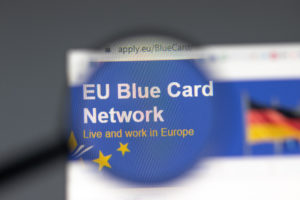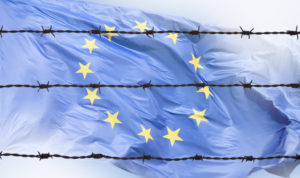Will the EU’s second attempt at attracting highly skilled migrant workers succeed?
The Blue Card is Europe’s answer to the US Green Card. That’s at least how the European Union has billed its immigration scheme for highly skilled workers, launched a decade ago. Under the 2009 Blue Card Directive, the EU grants work and residence permits to non-EU/EEA nationals and their families in 25 of the 27 member states. Ireland and Denmark do not participate in the programme.
 These permits are valid for the length of the work contract and up to three years, but can be renewed. Applicants have to prove “higher professional qualifications”, fulfil the legal requirements for regulated professions, work as an employee (self-employed entrepreneurs are excluded), have the necessary travel documents and health insurance and have a work contract or binding job offer in an EU country for a minimum of one year, with a salary of at least 1.5 times the destination country’s average gross annual salary. Asylum seekers and so-called “irregular migrants”, i.e. those who have crossed into the EU without a visa, are presently excluded from the programme.
These permits are valid for the length of the work contract and up to three years, but can be renewed. Applicants have to prove “higher professional qualifications”, fulfil the legal requirements for regulated professions, work as an employee (self-employed entrepreneurs are excluded), have the necessary travel documents and health insurance and have a work contract or binding job offer in an EU country for a minimum of one year, with a salary of at least 1.5 times the destination country’s average gross annual salary. Asylum seekers and so-called “irregular migrants”, i.e. those who have crossed into the EU without a visa, are presently excluded from the programme.
While the Blue Card scheme was meant to address a lack of labour and skills in the EU and the European Economic Area and remove obstacles for highly skilled third-country workers to move between different countries, it was not the success it aspired to be. A comparison with the US shows why. While there are around 14 million Green Card holders in the United States – two thirds of which are entitled to claim US citizenship-, the figures for the EU Blue Card are somewhere in the lower hundreds of thousands. And this despite the fact that the EU has a larger population than the US.
Bottleneck
“The EU’s immigration system for highly skilled workers is not well equipped for the current and future challenges”, the European Commission noted. In its impact assessment, the Commission added: “The EU skills shortages are most manifest in fields such as healthcare, ICT, and engineering, which rely essentially on STEM (Science, Technology, Engineering and Mathematics) skills. The highest growth in employee numbers in the EU takes place in occupations requiring higher-level skills (18 out of 25). Also, the EU top 20 bottleneck occupations include seven highly skilled occupations, although some medium skilled occupations are also affected, in particular for skilled manual occupations in sectors such as manufacturing, construction and transport.” Knowledge-intensive services, high-tech manufacturing and new technologies that underpin Europe’s future competitiveness would require Europe to “up its game” in terms of skills development, the Commission argued.
Already back in 2016, i.e. only a few years after the Blue Card scheme had gone into effect, the EU executive said the system was in need of reform. Weaknesses of the programme included very restrictive admission conditions and limited intra-EU mobility for Blue Card holders. This was compounded by various sets of parallel rules, conditions and procedures and application of the programme in the various EU countries, most of which continued their national immigration schemes in parallel.
Agreement
After years of negotiations, the main EU institutions – Commission, Council and Parliament – reached an agreement. Under the new rules, the minimum salary required to qualify for a Blue Card is to be reduced. It can be as low as the average gross annual salary in the country concerned (currently, the minimum threshold is 1.5 annual gross salaries). The minimum duration for a work contract will be reduced to six months, and Blue Card holders can change employers in the EU more easily in the future. In order to attract and retain skilled workers from outside the EU, family members will not only be able to accompany them, but seek a job themselves.

Is the EU too restrictive when it comes to labour migration?
The current requirements for the recognition of professional skills for occupations in the IT and communications sectors will also be relaxed. Applicants in other sectors with an experience equivalent to a higher education qualification will also become eligible to apply. Another change: Highly skilled beneficiaries of international protection will become eligible to apply for an EU Blue Card.
Blue Card holders and their family members will also be able to move on to a second member state after one year employment in the EU state where they arrived. Periods of time spent working in different EU countries will henceforth be taken into account, which the EU believes will facilitate easier access to long-term resident status.
“We must make sure that we are equipped to compete in the global search for talent”, said Eduardo Cabrita, interior minister of Portugal, which currently holds the rotating presidency of the Council. He added: “The revised rules for the EU blue card provide an EU-level scheme that allows more flexibility, improved conditions and simplified mobility, placing the EU firmly among the top destinations for highly qualified workers.” European Commission Vice-President Margaritis Schinas was equally optimistic and spoke of a “modern, targeted legal migration scheme that will allow us to respond to skills shortages and make it easier for highly skilled professionals to join our workforce.”
However, the new Blue Card Directive won’t have any immediate effects. Once formally adopted by the European Parliament and the Council, EU member states participating in the scheme will have two years to transpose the new rules into their national laws.
Author: Michael Thaidigsmann






